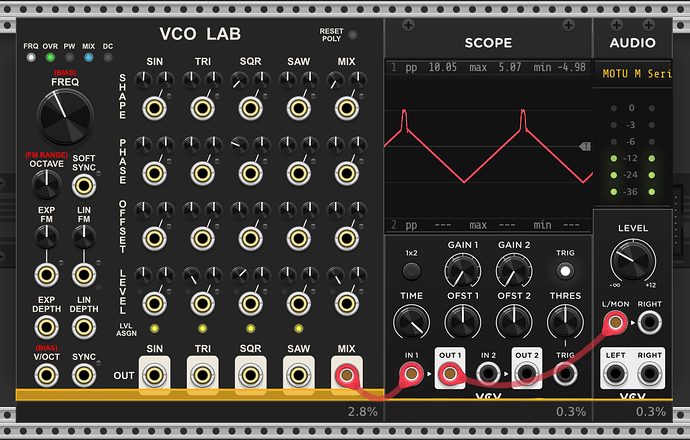hi there, inspired and fascinated by the tutorials from @pyer and try to patch my own ideas with it. i’m struggeling with the correct modukes to build a buchla 261e. does it contain two vco, a waveshaper and a wavefolder? cannot find in depth information about it. does anyone know sonething about? thanks karl
200e_Users_Guide_v1.4.pdf (1.5 MB)
This is the manual of the whole 200e series. The 261e is in there.
In essence it consists of 2 oscillators, two separate waveshaper circuits with a wavefolder in the circuit for the primary oscillator. The waveshaping of the primary oscillator has three parameters, which are:
Timbre, symmetry and high order.
Timbre adds harmonics (the wavefolder) Symmetry shifts the waveshape effect on each half (bias) High order works like a high pass filter, but it is not a filter. It turns the wave into a so-called spike wave by removing low harmonics. The S-wave module by DHE does this in a way.
Also check the DPO descriptions by MakeNoise. It gives more clues ![]() Have fun!
Have fun!
thank you very much for the quick info.
now i have to read understand a bit more ![]()
The spike wave is a special case. The developer of MakeNoise, Tony Rolando, once described it as a wave that you can synthesize it by “deriving a portion from a square wave and scanning with it through the related triangle wave” (when describing the overtone section of the 0 Coast)
I kinda figured it out -since I like to unravel a mystic description of synthesis ![]()
When I am back at my computer, I will share a version of it. May take a while though -too busy being on the road for concerts
You could check the youtube video on the emulation of the 0 Coast by @Omri_Cohen from awhile back. He uses the S wave module by DHE. But the waveshaping chain is sort of similar to the circuit of the primary oscillator of the 261e, albeit a bit simpler. It pointed me to the right direction back then!
hello again, very interesting video. thank you. i decided and patched something with tge following modules. will upload the patch next days. main oscillator surgext sinus wavefolder from msm swave from dhe vco output, wavefolder and swave mixed with vcv mixer4.
modulation oscillator vernom vcolab, because of all neccessary modulations in one module,as far as i understand. keyframer for blending the waveforms. surgext treemonster for pitchtracking.
what i did not find, is an explanation of the difference of squarewave abd pulsewave. any ideas? and i do not know, how to connect both.
when you use S Wave, you do not have to use a square/pulse wave (a square wave is a pulse wave with a 50/50 duty cycle) But instead of using the S Wave module, you can use a windowed comparator to create a pulse wave. With this you can create a spike wave from the triangle.
The waveshaping is being done by crossfading between the sine (or saturated triangle) and the spike wave. Here, let me show you (the video has no sound, in case you are wondering)
Hope it helps!
You can use pretty much any comparator along with any VCO to get a spiked triangle. The Venom WinComp has the advantage that it can apply oversampling (context menu) to mitigate aliasing.
But you can get a spiked triangle easily enough using only a single VCO Lab.
- Set the Mix Shape mode to Average (No shaping)
- Set the Mix Level to 100%
- Set the Tri Level to 100%
- Set the Sqr Shape (pulse width) to 3% (fully counter-clockwise)
- Set the Sqr Level to some positive value. In the picture I am at 30%
- Use the Sqr Phase to position the spike at the triangle peak. I am using -83%
You can freely adjust the amount of spike by varying the Sqr Level. The Mix averaging will continuously keep the output 10V peak to peak.
Thank you, will test it. I think it is possible to create a spikewave i need. Its nearly a peak as far as i understand the documentation. The knob rotates from sin, tri, sqr, spike.
True… but ![]() With your version there is only a spike on the positive side. The original spike is bipolar.
With a windowed comparator you will get this.
With your version there is only a spike on the positive side. The original spike is bipolar.
With a windowed comparator you will get this.
Doh! How did I miss that!


